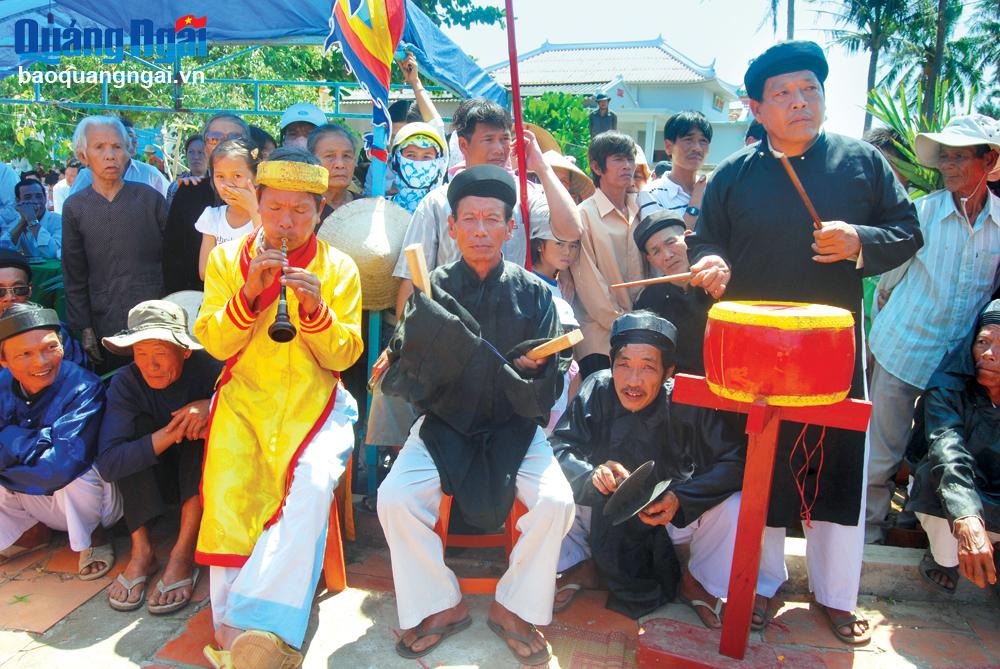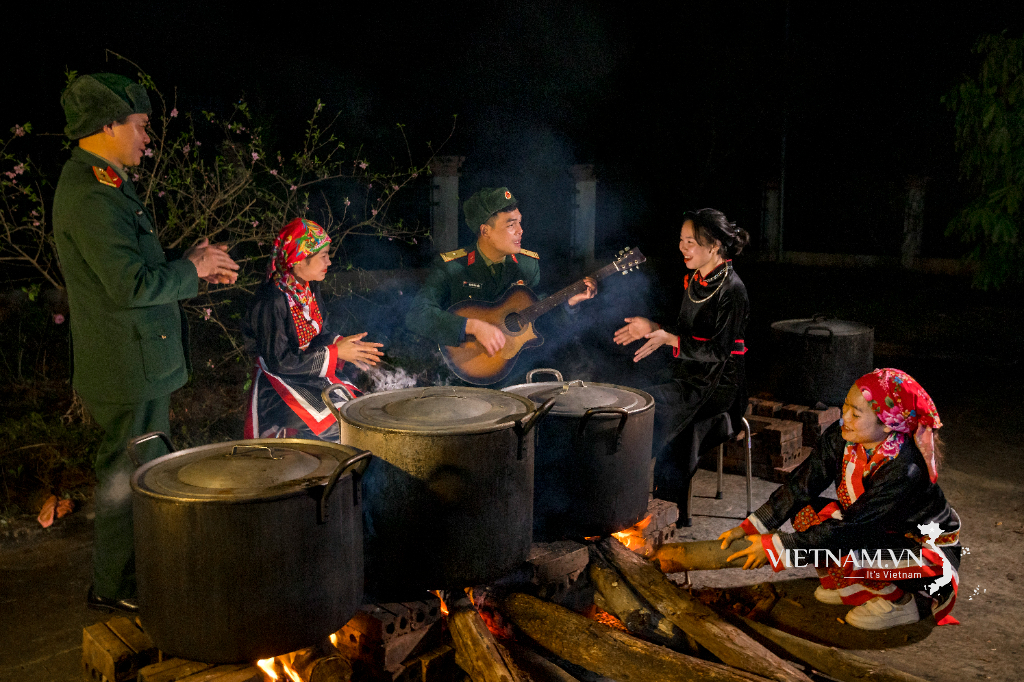( Quang Ngai Newspaper) - Until now, every time I hear the deep and solemn sound of drums and gongs, it reminds me of the sounds of the village's communal house and temple ceremonies in the past. It seems that any folk ritual or festival cannot be without the jubilant sounds of the five-tone music. The sounds of drums, gongs, trumpets, and flutes resound like joyful songs urging everyone to eagerly participate in the village festival.
In the past, traditional music groups often had five people playing five different musical instruments, so they were often called pentatonic music groups, which are the five sounds: Kim, Ty, Truc, Cach, Moc. Kim is the sound of musical instruments made from metal such as gongs, cymbals, cymbals, and brass trumpets. Ty is the sound of silk strings used in the two-stringed fiddle and the moon-shaped lute. Truc is the sound of flutes and flutes made from bamboo tubes. Cach is the sound made from a piece of buffalo or cowhide stretched and covered at both ends, creating sounds like a big drum, a rice drum, or a worship drum. Moc is the sound of wood when struck like a clapper or a wooden fish. Each traditional pentatonic musical instrument has its own timbre, and when played together, it creates a unique symphony, sometimes sad and sorrowful, sometimes gentle, high-pitched, majestic, and bustling.
 |
| A pentatonic band in Ly Son district. |
Some villages in the North Central region such as Hue, Quang Binh , Thanh Hoa often play octagonal music in traditional ceremonies and operas. In Quang Ngai, it is rarely seen, if it is used, there are only two more sounds: "thach", the sound emitted from stone such as stone gongs, lithophones, conch shells (the sound of conch shells in the Hoang Sa soldier's memorial ceremony) and "bao", which is the sound of a gourd, often made by ethnic minorities from dried gourd shells, such as the b'rook of the Hre and Cor people. Each pentatonic or octagonal musical instrument carries within it cultural, spiritual, aesthetic and artistic values unique to each region.
In the rituals of the communal houses and temples in the two villages of An Hai and An Vinh on Ly Son island, people usually have a five-tone band to accompany the ceremony, including: Drum music (a small drum, the sound of cach), cymbals (called senh tien, the sound of metal), phach (two wooden sticks that beat the rhythm, the sound of wood), trumpets and zithers. According to the ritual order, at the beginning, people always chant the sentence: "Khoi chinh co, cac tam nghiem", which means beating the gong and drum three times; "nhac sinh tui vi", then the band takes its position to play the music. According to the steps of the traditional ritual, there must be 3 steps to perform the ritual including so hien le, a hien le and chung hien le. The band will play 3 songs according to each ritual step, "Nam, Xay, Dan" to the rhythm of the drum music, the person who beats the rhythm for the band. The big drum and gong are 2 special musical instruments, used to open and close the rituals. The sound of the drums is sometimes bustling, sometimes climaxing depending on the situation. If the drums are played in a village festival, they encourage and cheer strongly. The louder the drums, the more exciting they are, like the drums in the Four Spirits Boat Racing Festival. With each step of the ceremony, the traditional five-tone sound is heard, as if blending into people's hearts, creating a deep resonance as if reminding everyone to remember the great contributions of our ancestors who once paraded troops to open up the country and pacify the borderlands, until the jubilant drums urge everyone to join the festival.
| The previous class teaches the next class. Playing traditional musical instruments in the village community in Quang Ngai is mainly inherited, taught through folklore. Those who know how to play the instrument, play the drum, blow the trumpet, or play the zither and clapper will, when they are old, teach the younger generation about the musical procedures in ceremonies and village festivals. Playing musical instruments in ceremonies is voluntary, without remuneration, mainly to serve the gods and are invited to eat and drink by the communal house, temple, and clan leaders after the ceremony or village festival ends. |
In the art of performing folk songs of Quang Ngai, people often use a five-tone orchestra, but only the drum, the fiddle, the clapper, and the moon lute to accompany the artists singing the bai choi, and the sound of the signal drum urges Mr. Hieu to sing and hand over the flag to the player when winning is getting 3 flags. Sometimes, the player of the bai choi music only uses musical instruments such as clappers, the fiddle, and the drum. In the art of singing sac bua, the sounds of the drum, the fiddle, the clapper, and the sen tien are indispensable. The singer of sac bua and the band will follow the rhythm of the drum and music of the leader of the singing troupe. Therefore, in folk ceremonies and performances, if there are no sounds in the five-tone orchestra, it will be quite bland, unfun, and the soul will be lost. Currently, in the festivals of praying for fishermen to go fishing; the Nam Hai god worshiping ceremony, Thanh Thuy mausoleum in Binh Hai commune (Binh Son), Thach Bi mausoleum in Sa Huynh, Pho Thanh ward (Duc Pho town); The ceremony to worship the goddess Thien YA Na... must have a pentatonic band to accompany the ceremony.
However, in some rituals in some places, in addition to the two typical musical instruments of drums and gongs, other musical instruments are lacking. For example, in the Truong Ba Temple Festival in Tra Xuan town (Tra Bong), only drums and gongs of the Cor people are played during the festival, while the ceremony inside the temple only has the sound of drums and gongs, sometimes there are rice drums, clappers and co lutes accompanying the ceremony, while other musical instruments are lacking. This shows that those who play traditional musical instruments are gradually disappearing, and it is feared that pentatonic music will also disappear from rituals if not cared for and preserved.
Nowadays, most of the traditional pentatonic musical instruments are kept in communal houses, temples, clan churches, or are kept by the players in the musical group, and are used only when there is a festival or a family death anniversary. The preservation of the musical instruments must also be very careful and taboo, not allowing anyone to step over or damage them. Playing music during festivals also avoids the player, that person has no mourning in the family.
Article and photos: VO MINH TUAN
RELATED NEWS:
Source: https://baoquangngai.vn/van-hoa/202406/tieng-nhac-ngu-am-ngay-xua-a8d39bb/



























![[Photo] National Assembly Chairman attends the seminar "Building and operating an international financial center and recommendations for Vietnam"](https://vphoto.vietnam.vn/thumb/1200x675/vietnam/resource/IMAGE/2025/7/28/76393436936e457db31ec84433289f72)








































































Comment (0)